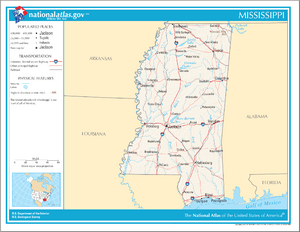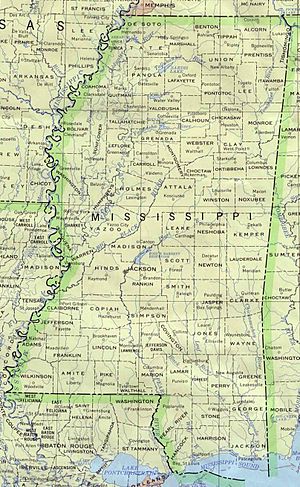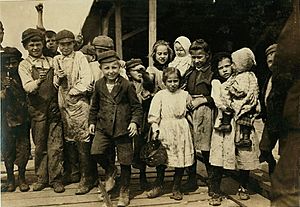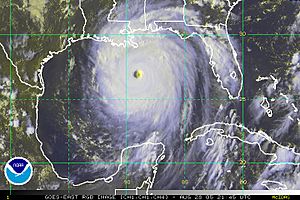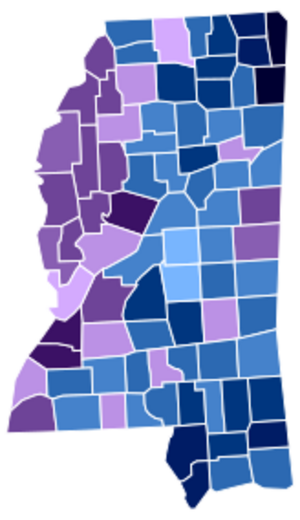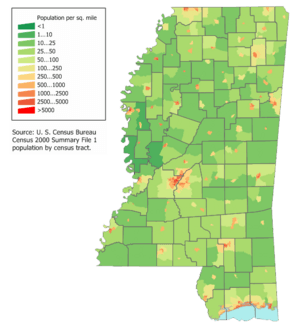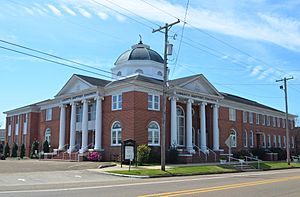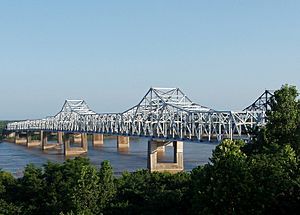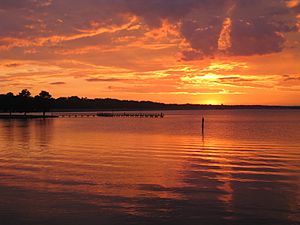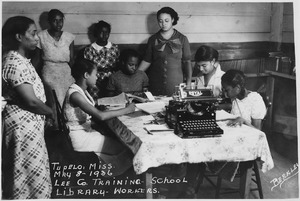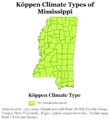Mississippi facts for kids
Quick facts for kids
Mississippi
|
|||
|---|---|---|---|
|
|||
| Nickname(s):
"The Magnolia State" and "The Hospitality State"
|
|||
| Motto(s): | |||
| Anthem: "One Mississippi" | |||
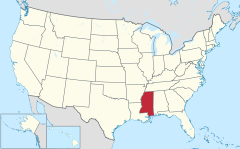
Map of the United States with Mississippi highlighted
|
|||
| Country | United States | ||
| Before statehood | Mississippi Territory (1798-1817) |
||
| Admitted to the Union | December 10, 1817 (20th) | ||
| Capital (and largest city) |
Jackson | ||
| Largest metro | Greater Jackson | ||
| Legislature | Legislature | ||
| • Upper house | Senate | ||
| • Lower house | House of Representatives | ||
| Judiciary | Supreme Court of Mississippi | ||
| U.S. senators | Roger Wicker (R) Cindy Hyde-Smith (R) |
||
| U.S. House delegation | 1: Trent Kelly (R) 2: Bennie Thompson (D) 3: Michael Guest (R) 4: Mike Ezell (R) (list) |
||
| Area | |||
| • Total | 48,430 sq mi (125,443 km2) | ||
| • Land | 46,952 sq mi (121,607 km2) | ||
| • Water | 1,521 sq mi (3,940 km2) 3% | ||
| Area rank | 32nd | ||
| Dimensions | |||
| • Length | 340 mi (545 km) | ||
| • Width | 170 mi (275 km) | ||
| Elevation | 300 ft (90 m) | ||
| Highest elevation | 807 ft (246.0 m) | ||
| Lowest elevation | 0 ft (0 m) | ||
| Population
(2024)
|
|||
| • Total | |||
| • Rank | 35th | ||
| • Density | 63.5/sq mi (24.5/km2) | ||
| • Density rank | 33rd | ||
| • Median household income | $54,200 (2023) | ||
| • Income rank | 50th | ||
| Demonym(s) | Mississippian | ||
| Language | |||
| • Official language | English | ||
| Time zone | UTC−06:00 (Central) | ||
| • Summer (DST) | UTC−05:00 (CDT) | ||
| USPS abbreviation |
MS
|
||
| ISO 3166 code | US-MS | ||
| Trad. abbreviation | Miss. | ||
| Latitude | 30°12′ N to 35° N | ||
| Longitude | 88°6′ W to 91°39′ W | ||
| Dance | Square dance |
|---|---|
| Bird | Northern mockingbird (Mimus polyglottos) |
| Fish | Largemouth bass (Micropterus salmoides) |
| Flower | Magnolia |
| Tree | Southern magnolia (Magnolia grandiflora) |
| Insect | Western honey bee (Apis mellifera) |
Mississippi ( MISS-iss-IP-ee) is a state in the Southeastern part of the United States. It shares borders with Tennessee to the north and Alabama to the east. To the south, it meets the Gulf of Mexico and Louisiana. Its western side borders Louisiana and Arkansas, mostly along the Mississippi River.
Mississippi is the 32nd largest state by land area. It is the 35th most populated among the 50 U.S. states. Jackson is both the state's capital and its biggest city. The Greater Jackson area is home to over 590,000 people. Other important cities include Gulfport, Southaven, and Hattiesburg.
The state's history began around 9500 BC with the first people, called Paleo-Indians. Over time, farming societies grew, and the Mound Builders and Mississippian culture thrived. Europeans, starting with the Spanish in the 1500s, later explored the area. The French began to settle here in the 1600s. Mississippi's location on the Mississippi River was very important for trade. It became wealthy from cotton farms before the American Civil War.
Mississippi joined the United States as the 20th state on December 10, 1817. By 1860, it was the top cotton producer in the nation. At that time, more than half of its population were enslaved people. Mississippi left the Union on January 9, 1861. It was one of the first seven states to form the Confederate States. After the Civil War, Mississippi rejoined the Union on February 23, 1870. The state's history was greatly shaped by the Civil War and the civil rights movement.
Mississippi still faces challenges in health, education, and economic growth. It often ranks lower than other states in these areas. The state's economy relies on agriculture, manufacturing, and growing tourism. Mississippi produces a lot of farm-raised catfish. It is also a top producer of sweet potatoes, cotton, and wood pulp. The state's landscape is mostly low plains and hills. The Mississippi Delta is in the northwest. Woodall Mountain is the highest point, and the Gulf of Mexico is the lowest. Mississippi has a warm, wet climate.
Mississippi is known for its strong religious beliefs. Many people here consider religion a central part of their lives. It also has the highest percentage of African-American residents. The state's government has three main branches: legislative, executive, and judicial. Mississippi has a rich cultural history, especially in music. It is known as the birthplace of the blues.
Contents
- What's in a Name? The Meaning of Mississippi
- Exploring Mississippi's Geography
- A Look at Mississippi's Past
- How Mississippi's Government Works
- People and Population in Mississippi
- Mississippi's Economy
- Getting Around: Transportation in Mississippi
- Mississippi's Culture and Arts
- Mississippi in Popular Culture
- Learning in Mississippi: Education
- Images for kids
- See also
What's in a Name? The Meaning of Mississippi
The state's name comes from the Mississippi River. This river flows along its western border. Early settlers named it after the Ojibwe word misi-ziibi. This word means "Great River."
Exploring Mississippi's Geography

Mississippi is bordered by Tennessee to the north and Alabama to the east. To the south, it has a small coast on the Gulf of Mexico and borders Louisiana. To the west, across the Mississippi River, are Louisiana and Arkansas.
Besides the Mississippi River, other important rivers include the Big Black River, the Pearl River, the Yazoo River, the Pascagoula River, and the Tombigbee River. Major lakes are Ross Barnett Reservoir, Arkabutla Lake, Sardis Lake, and Grenada Lake. Sardis Lake is the largest.
Mississippi is mostly made up of lowlands. The highest point is Woodall Mountain, which is 807 feet (246 meters) above sea level. This mountain is in the foothills of the Cumberland Mountains. The lowest point is at sea level along the Gulf coast. The state's average elevation is 300 feet (91 meters) above sea level.
Most of Mississippi is part of the East Gulf Coastal Plain. This area has low hills, like the Pine Hills in the south. The Pontotoc Ridge and Fall Line Hills in the northeast are a bit higher. Yellow-brown soil is found in the western parts. The northeast has fertile black earth, which extends into the Alabama Black Belt.
The coastline has large bays at Bay St. Louis, Biloxi, and Pascagoula. The shallow Mississippi Sound separates it from the Gulf of Mexico. This sound is partly protected by several islands, including Petit Bois, Horn, Ship, Deer, Round, and Cat Islands.
The northwest part of the state is the Mississippi Delta. This area is part of the Mississippi Alluvial Plain. It is narrow in the south and gets wider north of Vicksburg. The Delta has very rich soil. This soil was formed by silt left behind by the flood waters of the Mississippi River.
Major Cities and Towns in Mississippi
Here are some of Mississippi's largest cities by population (as of 2017):
- Jackson (166,965 people)
- Gulfport (71,822 people)
- Southaven (54,031 people)
- Hattiesburg (46,377 people)
- Biloxi (45,908 people)
- Tupelo (38,114 people)
- Meridian (37,940 people)
- Olive Branch (37,435 people)
- Greenville (30,686 people)
Mississippi's Climate and Weather
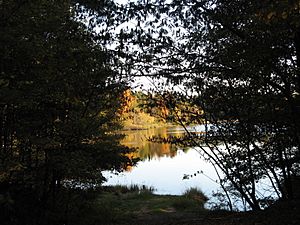
Mississippi has a humid subtropical climate. This means it has long, hot summers and short, mild winters.
Late summer and fall are when hurricanes can move inland from the Gulf of Mexico. This is especially true for the southern part of the state. Hurricane Camille in 1969 and Hurricane Katrina in 2005 were very powerful. Both caused huge damage to cities like Gulfport, Biloxi, and Pascagoula. Hurricane Katrina sadly caused 238 deaths in the state.
Like other states in the Deep South, Mississippi often has thunderstorms. On average, Mississippi sees about 27 tornadoes each year. The northern part of the state gets more tornadoes earlier in the year. The southern part has more later in the year. Two of the five deadliest tornadoes in U.S. history happened in Mississippi. These hit Natchez and Tupelo.
Nature and Wildlife in Mississippi
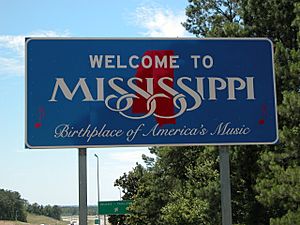
Mississippi is a very forested state. More than half of its land is covered by wild trees. These include mostly pine trees. Other common trees are cottonwood, elm, hickory, oak, pecan, sweetgum, and tupelo.
Dealing with Flooding in Mississippi
The Mississippi and Yazoo rivers often flood from December to June. These floods have created a very fertile floodplain in the Mississippi Delta. People built levees, or raised banks, to try and stop the rivers from flooding their cotton fields.
Historically, workers built these levees higher to protect farms. Even with more scientific knowledge, floods can still be severe. This is because clearing land and building levees have changed how the river flows. The state and federal governments are working to restore natural habitats. This helps the river's ecosystem work better.
A Look at Mississippi's Past
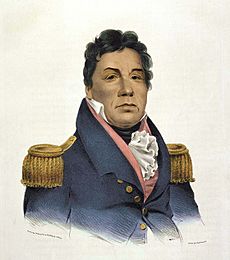
Around 10,000 BC, Native Americans first arrived in the area that is now the American South. These early people were hunter-gatherers. They hunted large animals that are now extinct. In the Mississippi Delta, Native American villages and farms were built on higher ground near rivers.
The first major European explorer in Mississippi was Hernando de Soto from Spain. He traveled through the northeast part of the state in 1540.
Colonial Times in Mississippi
In April 1699, French settlers created the first European town. It was called Fort Maurepas, near today's Ocean Springs on the Gulf Coast.
In 1716, the French started Natchez on the Mississippi River. They called it Fort Rosalie. This town became a very important trading center. The French named this large area "New France." During the 1700s, Spanish, French, and British governments ruled the area at different times. They brought enslaved Africans to work as laborers.
After the French and Indian War, the French gave the Mississippi area to Great Britain in 1763.
Becoming a U.S. Territory
After the American Revolution, Britain gave this land to the new United States. The Mississippi Territory was formed on April 7, 1798. It was made from land given by Georgia and South Carolina.
From 1800 to about 1830, the U.S. bought land from Native American tribes. This was for new European-American settlements. On September 27, 1830, the Treaty of Dancing Rabbit Creek was signed. This treaty was between the U.S. Government and the Choctaw people. The Choctaw agreed to sell their lands in Mississippi and Alabama. They moved to reservations in Indian Territory (now Oklahoma).
Some Choctaw chose to stay in Mississippi. They became U.S. citizens. Today, about 9,500 Choctaw live in Neshoba, Newton, Leake, and Jones counties. The Mississippi Band of Choctaw Indians is a federally recognized tribe.
Many slaveholders brought enslaved people with them. They also bought them through the slave trade. Almost one million enslaved people were moved to the Deep South, including Mississippi. This forced migration broke up many families.
Mississippi Becomes a State (1817-1861)
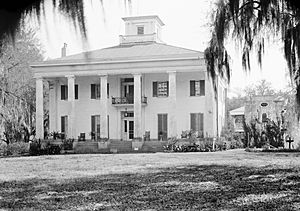
Mississippi became the 20th state to join the Union on December 10, 1817.
Large farms, called plantations, grew along the major rivers. These rivers provided easy transport for crops. By the 1850s, when cotton was very important, Mississippi plantation owners became very rich. This was due to fertile soil, high cotton prices, and their enslaved workers.
By 1860, there were 436,631 enslaved African Americans in Mississippi. They made up 55% of the state's total population. There were fewer than 1,000 free African Americans.
From Civil War to the 1900s
On January 9, 1861, Mississippi was the second state to leave the Union. It was one of the first states to form the Confederate States. These were states with the most enslaved people.
During the war, Union and Confederate forces fought for control of the Mississippi River. This river was vital for supplies and trade. More than 80,000 Mississippians fought in the Civil War. Many were killed or wounded. Union General Ulysses S. Grant's long siege of Vicksburg gave the Union control of the river in 1863.
After the war, during Reconstruction, Mississippi created a new constitution in 1868. This was the first time African Americans were part of the state's political groups. Mississippi rejoined the Union on February 23, 1870.
After the Civil War, many people moved to Mississippi for higher wages. In the 1870s and 1880s, many black farmers were able to buy their own land.
In 1875, Democrats took back control of the state government. They used violence and threats against black and white citizens. This was called the "white line" campaign. Riots happened in several towns. Well-armed white groups broke up black meetings and killed black leaders. This led to many black and white men being removed from voter lists.
Despite these challenges, black Mississippians continued to be elected to local offices. However, new laws called Jim Crow laws were put in place. These laws created racial segregation. There was also an increase in killings of black people, mostly men, from the 1890s to 1930.
Cotton crops were also damaged by the boll weevil insect. Severe floods in 1912 and 1913 caused more problems. This created hard times for many African Americans.
Mississippi in the 20th Century and Today
In 1900, more than half of Mississippi's population was black. By 1910, most black farmers in the Delta had lost their land. They became sharecroppers, working on others' land.
Starting around 1913, many black Americans left Mississippi. This was part of the Great Migration. They moved to northern cities like St. Louis, Chicago, and New York. They sought better jobs and lives.
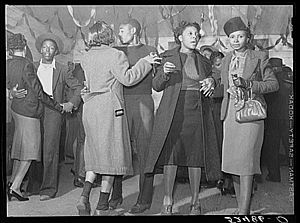
In the early 1900s, some industries started in Mississippi. But jobs were often only for white people. The lack of jobs also made some white people move north. The state relied on farming. However, new machines meant fewer farm workers were needed.
The call for equal rights for African Americans grew stronger in the 1930s and 1940s.
The Second Great Migration began in the 1940s and lasted until 1970. Nearly half a million people left Mississippi. Most of them were black. They moved to the West, especially California. There, defense industries offered better-paying jobs.
Black and white people in Mississippi created amazing American music. This includes gospel music, country music, jazz, blues, and rock and roll. Many Mississippi musicians helped create or develop these styles. Many carried their music to Chicago, making it a center for jazz and blues.
So many African Americans left during the Great Migration that they became a minority in Mississippi after the 1930s.
The Civil Rights Movement was strongly supported by churches. Black churches helped organize efforts to educate and register black voters. They also worked for integration.
After many years of being unable to vote, African Americans in Mississippi slowly regained their voting rights. This happened after new federal laws in 1964 and 1965. These laws ended official segregation and protected voting rights.
On August 17, 1969, Hurricane Camille hit the Mississippi coast. It was a very strong storm. It killed 248 people and caused a lot of damage.
On August 29, 2005, Hurricane Katrina also caused huge destruction. It hit the entire 90 miles (140 km) of the Mississippi Gulf Coast.
How Mississippi's Government Works
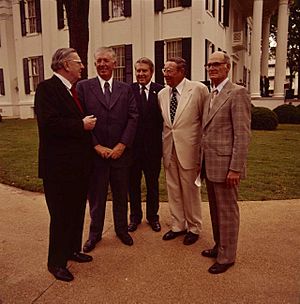
Like other U.S. states, Mississippi's government has three separate parts:
- The legislative branch makes laws.
- The executive branch carries out laws.
- The judicial branch interprets laws.
The Governor leads the executive branch. The lieutenant governor is also elected separately. Both serve four-year terms. Unlike the federal government, many heads of state departments are elected by the people, not chosen by the governor.
Mississippi is one of five states that hold state elections in odd-numbered years. These elections happen every four years, right before presidential elections.
People and Population in Mississippi
| Historical population | |||
|---|---|---|---|
| Census | Pop. | %± | |
| 1800 | 7,600 | — | |
| 1810 | 31,306 | 311.9% | |
| 1820 | 75,448 | 141.0% | |
| 1830 | 136,621 | 81.1% | |
| 1840 | 375,651 | 175.0% | |
| 1850 | 606,526 | 61.5% | |
| 1860 | 791,305 | 30.5% | |
| 1870 | 827,922 | 4.6% | |
| 1880 | 1,131,597 | 36.7% | |
| 1890 | 1,289,600 | 14.0% | |
| 1900 | 1,551,270 | 20.3% | |
| 1910 | 1,797,114 | 15.8% | |
| 1920 | 1,790,618 | −0.4% | |
| 1930 | 2,009,821 | 12.2% | |
| 1940 | 2,183,796 | 8.7% | |
| 1950 | 2,178,914 | −0.2% | |
| 1960 | 2,178,141 | 0.0% | |
| 1970 | 2,216,912 | 1.8% | |
| 1980 | 2,520,638 | 13.7% | |
| 1990 | 2,573,216 | 2.1% | |
| 2000 | 2,844,658 | 10.5% | |
| 2010 | 2,967,297 | 4.3% | |
| 2020 | 2,961,279 | −0.2% | |
| Source: 1910–2020 | |||
The middle point of Mississippi's population is in Leake County, near the town of Lena.
In 2019, the population of Mississippi was estimated to be about 2,976,149 people. This was a small increase since the 2010 census. However, some people have moved away for better job opportunities.
From 2000 to 2010, Mississippi saw a big increase in people identifying as mixed-race. This group grew by 70%. It now makes up 1.1% of the population. Mississippi also led the nation in the growth of mixed marriages. This change shows that more people are choosing to identify with all parts of their heritage.
Historically, after Native Americans were moved in the 1830s, the main groups were black (African American) and white (European American). Today, African Americans make up about 37.8% of the state's population. Most of their ancestors were enslaved. Many were brought from the Upper South in the 1800s to work on new plantations. Some also have Native American or European ancestors.
During the first half of the 20th century, nearly 400,000 African Americans left Mississippi. This was part of the Great Migration. They sought jobs and better lives in the North, Midwest, and West. Because of this, African Americans became a minority in the state for the first time in its history.
Who Lives in Mississippi? Ancestry and Backgrounds
| Race and Ethnicity | Alone | Total | ||
|---|---|---|---|---|
| White (non-Hispanic) | 55.4% |
|
57.9% |
|
| African American (non-Hispanic) | 36.4% |
|
37.6% |
|
| Hispanic or Latino | — | 3.6% |
|
|
| Asian | 1.1% |
|
1.5% |
|
| Native American | 0.5% |
|
1.6% |
|
| Pacific Islander | 0.04% |
|
0.1% |
|
| Other | 0.2% |
|
0.7% |
|
| Racial composition | 1990 | 2000 | 2010 |
|---|---|---|---|
| White | 63.5% | 61.4% | 59.1% |
| Black | 35.6% | 36.3% | 37.0% |
| Asian | 0.5% | 0.7% | 0.9% |
| Native | 0.3% | 0.4% | 0.5% |
| Other race | 0.1% | 0.5% | 1.3% |
| Two or more races | – | 0.7% | 1.2% |
In 2011, more than half of Mississippi's population under age 1 were minorities. This means they had at least one parent who was not non-Hispanic white.
Many Mississippians have Scots-Irish, English, and Scottish ancestors. These groups are often under-reported in census data. This is because their immigrant ancestors came to North America many centuries ago. Many people with these backgrounds simply identify as "American."
Mississippi has the highest percentage of African Americans in the nation. This percentage has started to grow again. This is mainly because the African-American population is younger. In most public school districts, African-American students are the majority. African Americans are the largest ethnic group in the northwest Yazoo Delta and the central and southwestern parts of the state. These are areas where African Americans historically owned land or worked on cotton farms.
People of French Creole background are the largest group in Hancock County on the Gulf Coast. Most African Americans, Choctaw (especially in Neshoba County), and Chinese American people in Mississippi were born in the U.S.
The first Chinese people came to Mississippi in the 1870s. They worked on cotton plantations. However, most Chinese families arrived later, between 1910 and 1930. They often ran small family grocery stores in the Delta's towns. These small towns have shrunk since the late 1900s. Many ethnic Chinese have moved to larger cities like Jackson. Their population in the state has grown in the 21st century.
In the early 1980s, many Vietnamese people moved to Mississippi. They often found jobs in fishing.
Languages Spoken in Mississippi
In 2000, 96.4% of Mississippi residents aged five and older spoke only English at home. This was a slight decrease from 97.2% in 1990. The English spoken in Mississippi is mostly Southern American English. Some parts of northern and eastern Mississippi have South Midland speech.
| Language | Percentage of population (as of 2010) |
|---|---|
| Spanish | 1.9% |
| French | 0.4% |
| German, Vietnamese, and Choctaw (tied) | 0.2% |
| Korean, Chinese, Tagalog, Italian (tied) | 0.1% |
Religion in Mississippi
When the French and Spanish ruled in the 1600s, most European settlers were Roman Catholics. After 1815, many Anglo-American settlers came. Most of them were Protestants from other Southeastern states. This led to a fast growth in Protestant churches, especially Methodist, Presbyterian, and Baptist churches.
The Great Awakening revivals in the late 1700s and early 1800s welcomed everyone. This included women and black people. Both enslaved and free black people were part of Methodist and Baptist churches. Independent black Baptist churches started before 1800 in other states. They later grew in Mississippi too.
After the Civil War, religion became even more important. The South became known as the "Bible Belt."
Since the 1970s, conservative churches have grown quickly. This has influenced Mississippi's conservative political trends among white people. In 1973, the Presbyterian Church in America attracted many conservative churches. In 2010, Mississippi had the highest number of followers for this group.
According to data from 2010, the Southern Baptist Convention was the largest religious group. It had over 907,000 followers. The United Methodist Church was next with over 204,000. The Roman Catholic Church had over 112,000 followers. Other religions like Islam, Hinduism, and the Baháʼí Faith have smaller numbers of followers.
Polls consistently show Mississippi as the most religious state in the U.S. About 59% of Mississippians say they are "very religious." Another survey found that 63% attend church weekly or almost weekly. This is the highest percentage of any state. In 2008, 85% of Mississippians said religion was an important part of their daily lives. This was also the highest in the nation.
| Affiliation | % of Mississippi population | |
|---|---|---|
| Christian | 83 |
|
| Protestant | 77 |
|
| Evangelical Protestant | 41 |
|
| Mainline Protestant | 12 |
|
| Black church | 24 |
|
| Catholic | 4 |
|
| Mormon | 1 |
|
| Jehovah's Witnesses | 0.5 |
|
| Eastern Orthodox | 0.5 |
|
| Other Christian | 0.5 |
|
| Unaffiliated | 14 |
|
| Nothing in particular | 11 |
|
| Agnostic | 3 |
|
| Atheist | 1 |
|
| Non-Christian faiths | 2 |
|
| Jewish | 0.5 |
|
| Muslim | 0.5 |
|
| Buddhist | 0.5 |
|
| Hindu | 0.5 |
|
| Other Non-Christian faiths | 0.5 |
|
| Don't know/refused answer | 1 |
|
| Total | 100 |
|
Mississippi's Economy
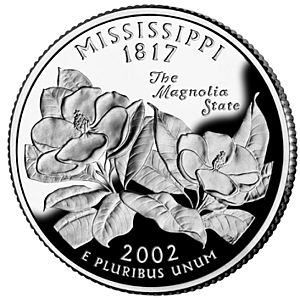
In 2010, Mississippi's total state product was $98 billion. In 2006, the average income per person was $26,908. This was the lowest in the U.S. However, Mississippi also has the lowest living costs in the nation. In 2015, the adjusted income per person was $40,105. Mississippians are also known for giving a lot to charity.
Mississippi has one of the lowest rates of people working, at 56%. About 70,000 adults, or 10% of the workforce, have disabilities.
Mississippi's economy was heavily based on cotton farming for a long time. This led to slower growth in other areas. The state also faced many natural disasters like floods. These required huge investments in levees.
Before the Civil War, Mississippi was one of the wealthiest states. This wealth came from the labor of enslaved people on cotton farms. Enslaved people were counted as property. Their value increased as cotton prices rose. By 1860, 55% of Mississippi's population was enslaved.
After the Civil War, the state lost a lot of its wealth. Many soldiers died or were injured. The economy struggled. It took years to rebuild levees damaged in battles. By 1868, cotton crops started to improve. However, the amount produced was still less than half of what it was before the war.
Poor white people and formerly enslaved people suffered most from the economic problems. In 1900, two-thirds of farm owners in Mississippi were black. This was a great achievement. But due to a poor economy and low cotton prices, many farmers lost their land. By 1920, most African Americans were sharecroppers again.
The state also faced problems like the boll weevil insect damaging cotton crops. There were also major floods in 1912–1913 and 1927. Cotton prices fell after 1920, and a drought hit in 1930. These issues made the state suffer greatly. During the Great Migration, hundreds of thousands of African Americans moved North and West. They sought jobs and full citizenship.
Fun and Tourism in Mississippi
In 1990, the state allowed casinos along the Mississippi River and Gulf Coast. This has brought more money and jobs to the state. Casino towns like Bay St. Louis, Gulfport, and Biloxi on the Gulf Coast attract many tourists. Towns along the Mississippi River, such as Tunica, Greenville, Vicksburg, and Natchez, also have casinos. Tunica is the third largest gaming area in the U.S.
Before Hurricane Katrina in 2005, Mississippi was the second-largest gambling state. Only Nevada had more gambling revenue. After the hurricane, many coastal casinos were badly damaged. Governor Haley Barbour signed a law in 2005. This law allowed casinos in Hancock and Harrison counties to rebuild on land, but still close to the water.
In 2012, Mississippi had the sixth-largest gambling revenue of any state. It brought in $2.25 billion. The federally recognized Mississippi Band of Choctaw Indians also has a casino on its land. The money from this casino helps support education and economic growth.
Manufacturing in Mississippi

Mississippi is a right-to-work state. This means workers cannot be forced to join a union. It has major car factories. These include the Toyota Mississippi Plant in Blue Springs. There is also a Nissan Automotive plant in Canton. The Nissan plant builds the Nissan Titan truck.
Taxes in Mississippi
Mississippi collects income tax in three levels, from 3% to 5%. The sales tax rate is 7%. Some cities, like Tupelo, add a local sales tax of 2.5%.
In 2007, a report said Mississippi was the poorest state. Large cotton farmers in the Delta have big, mechanized farms. They receive most of the federal money given to the state. However, many other residents are still poor, rural, and do not own land. The state's large poultry industry has also changed. It moved from family farms to big, mechanized operations.
Jobs in Mississippi
As of December 2018, Mississippi's unemployment rate was 4.7%. This was the seventh highest in the country.
Federal Help and Spending
Mississippi has a conservative approach to spending. It often reduces money for programs like Medicaid and food stamps. Despite this, Mississippi receives a lot of federal money. In 2005, for every dollar in taxes, Mississippians received about $2.02 in federal spending. This was the second highest in the nation. This number was high partly because of the large amount of federal aid needed after Hurricane Katrina.
A lot of federal money in Mississippi goes to large federal sites. These include Camp Shelby, John C. Stennis Space Center, Meridian Naval Air Station, Columbus Air Force Base, and Keesler Air Force Base.
Getting Around: Transportation in Mississippi
Air Travel
Mississippi has six airports with flights for passengers. The busiest are in Jackson (Jackson-Evers International Airport) and Gulfport (Gulfport-Biloxi International Airport).
Roads and Highways
Mississippi is the only U.S. state where people can legally drink beer in a car. However, some local areas have rules against this.
Mississippi has nine interstate highways:
 I-10
I-10
 I-110
I-110
 I-20
I-20
 I-220
I-220
 I-22
I-22 I-55
I-55 I-59
I-59 I-69
I-69
 I-269
I-269
It also has fourteen main U.S. Routes:
 US 11
US 11 US 45
US 45 US 49
US 49 US 51
US 51 US 61
US 61 US 72
US 72 US 78
US 78
 US 278
US 278
 US 80
US 80 US 82
US 82 US 84
US 84 US 90
US 90 US 98
US 98 US 425
US 425
The state also has a system of State Highways.
Train Travel in Mississippi
Passenger Trains
Amtrak offers passenger train service on two routes: the Crescent and the City of New Orleans. Before Hurricane Katrina, the Sunset Limited also traveled through the southern part of the state.
Freight Trains
Almost all major U.S. freight railroads serve Mississippi.
- Canadian National Railway's Illinois Central Railroad provides north-south service.
- BNSF Railway has a line across northern Mississippi.
- Kansas City Southern Railway offers east-west service in the middle of the state. It also has north-south service along the Alabama border.
- Norfolk Southern Railway serves the far north and southeast.
- CSX has a line along the Gulf Coast.
Waterways in Mississippi
Major Rivers
- Mississippi River
- Big Black River
- Pascagoula River
- Pearl River
- Tennessee-Tombigbee Waterway
- Yazoo River
Major Lakes and Reservoirs
- Arkabutla Lake: This lake has 19,550 acres (79 km2) of water. The U.S. Army Corps of Engineers manages it.
- Bay Springs Lake: It has 6,700 acres (27 km2) of water and 133 miles (214 km) of shoreline. The U.S. Army Corps of Engineers manages it.
- Grenada Lake: This lake has 35,000 acres (140 km2) of water. It started operating in 1954. The U.S. Army Corps of Engineers manages it.
- Ross Barnett Reservoir: This reservoir has 33,000 acres (130 km2) of water. It is named after Ross Barnett, a former Governor of Mississippi. It started operating in 1966. It provides water for the City of Jackson.
- Sardis Lake: This lake has 98,520 acres (399 km2) of water. It started operating in 1940. The U.S. Army Corps of Engineers manages it.
- Enid Lake: It has 44,000 acres (180 km2) of water. The U.S. Army manages it.
Mississippi's Culture and Arts
Mississippi is famous for its music and literature. It also has a strong tradition in other art forms. Its deep religious roots have inspired unique works by outsider artists. These artists have gained national attention.
Jackson hosts the USA International Ballet Competition every four years. This event brings talented young dancers from all over the world.
The Magnolia Independent Film Festival is held every year in Starkville. It is the first and oldest film festival in the state.
George Ohr, known as the "Mad Potter of Biloxi," lived and worked in Biloxi, MS. He is considered the father of abstract expressionism in pottery.
Music: The Heart of Mississippi
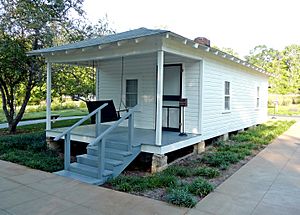
Musicians from the state's Delta region were very important in developing the blues.
Jimmie Rodgers, from Meridian, is known as the "Father of Country Music." He was a guitarist, singer, and songwriter. He also played a big part in the development of the blues.
The state is creating a Mississippi Blues Trail. This trail has markers that explain historic sites important to blues music. For example, Clarksdale's Riverside Hotel is where Bessie Smith died after a car accident. The Delta Blues Museum in Clarksdale attracts tourists from around the world. Nearby is "Ground Zero," a blues club co-owned by actor Morgan Freeman.
Elvis Presley, who became famous in the 1950s, was born in Tupelo. He helped create rock 'n' roll. From opera singer Leontyne Price to the band 3 Doors Down, and gulf and western singer Jimmy Buffett, Mississippi musicians have made a big impact on all kinds of music.
Mississippi in Popular Culture
- Children often count "One-Mississippi, two-Mississippi" during games like hide and seek. This helps them count seconds.
- Mississippi's low state rankings led to the saying "Thank God for Mississippi." This means someone is relieved their state isn't the lowest.
- On March 12, 1894, the Biedenharn Candy Company bottled the first Coca-Cola in Vicksburg, Mississippi. Root beer was invented in Biloxi in 1898 by Edward Adolf Barq. He is the person Barq's Root Beer is named after.
- The Teddy bear is named after President Theodore "Teddy" Roosevelt. In 1902, on a hunting trip in Sharkey County, Mississippi, he ordered a wounded bear to be put out of its misery.
- In 1935, the world's first outdoor night rodeo under electric lights happened in Columbia, Marion County, Mississippi. It was produced by Earl Bascom and Weldon Bascom.
- In 1936, Dr. Leslie Rush of Rush Hospital in Meridian, Mississippi, performed the first bone pinning in the U.S. The "Rush Pin" is still used today.
- Burnita Shelton Matthews from near Hazlehurst, Mississippi, was the first woman appointed as a judge of a U.S. district court. President Harry S. Truman appointed her in 1949.
- Texas Rose Bascom, from Columbia, Mississippi, became a famous female trick roper. She performed on stage and in Hollywood movies. She was the first Mississippian to be put into the National Cowgirl Hall of Fame.
- In 1963, Dr. James D. Hardy performed the first human lung transplant in Jackson, Mississippi. In 1964, he performed the first heart transplant from a chimpanzee to a human.
- On January 8, 1935, Elvis Presley was born in Tupelo.
- Several U.S. Navy ships have been named USS Mississippi.
- The comic book character Rogue from X-Men is from Mississippi. She calls herself a southern belle.
- In 2013, researchers at the University of Mississippi Medical Center found a way to cure HIV/AIDS in infants.
- Many novels by legal thriller writer John Grisham are set in a fictional town in northwest Mississippi.
- In Star Trek, Dr. Leonard "Bones" McCoy, the chief doctor on the U.S.S. Enterprise, studied medicine at the University of Mississippi Medical Center.
- Johnny Carson attended Millsaps College from 1943 to 1945. He was part of a Navy program to train officers.
- The film Mississippi Burning is based on events that happened in Mississippi in 1964. It stars Gene Hackman and Willem Dafoe.
Learning in Mississippi: Education
Before the Civil War, Mississippi had few schools. There were no schools for African Americans. The first school for black students opened in 1862.
During Reconstruction in 1871, a new constitution was written. It was the first to create a system of free public education in the state. However, the state's focus on farming and dislike of taxes limited money for schools. In the early 1900s, there were still few schools in rural areas, especially for black children. With help from the Julius Rosenwald Fund, many black communities raised money. They also contributed public funds to build new schools for their children. Many black adults taxed themselves twice and made big sacrifices. They even donated land or labor to build these schools.
Black and white students went to separate public schools in Mississippi until the late 1960s. This was despite the U.S. Supreme Court ruling it unconstitutional in 1954. In areas with many black students, white parents started private schools. These were called segregation academies. Public schools often lost funding.
However, most white children in the state still attended public schools. State officials knew they needed public education to attract new businesses. Many black parents felt they had little say in school management. They also felt their former administrators and teachers were pushed out. They had to work hard to ensure their interests and children were represented.
In the late 1980s, Mississippi had about 954 public schools. These schools taught about 369,500 elementary and 132,500 secondary students. About 45,700 students attended private schools.
In the 21st century, most children in Mississippi attend public schools. In 2008, Mississippi ranked last among states for academic achievement. It had the lowest average ACT scores. It also spent the sixth-lowest amount per student. However, Mississippi had the 17th-highest average SAT scores. This was because only a small number of high-achieving students took the SAT.
Jackson, the state capital, is home to the Mississippi School for the Deaf. This school was created by the state in 1854 for deaf and hard-of-hearing students.
Images for kids
-
Confederate lines, Vicksburg, May 19, 1863. Shows assault by US 1st Battalion, 13th Infantry
-
Mexican American boy and African American man at the Knowlton Plantation, Perthshire, Mississippi, in 1939, by Marion Post Wolcott
-
Köppen climate types of Mississippi, using 1991-2020 climate normals.
-
The Mississippi State Capitol was designated a National Historic Landmark in 2016.
See also
 In Spanish: Misisipi para niños
In Spanish: Misisipi para niños




